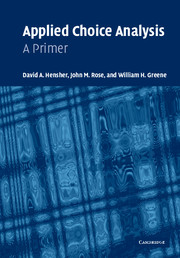Preface
Published online by Cambridge University Press: 05 September 2012
Summary
I'm all in favor of keeping dangerous weapons out of the hands of fools. Let's start with typewriters.
(Frank Lloyd Wright, 1868–1959)Almost without exception, everything human beings undertake involves a choice (consciously or sub-consciously), including the choice not to choose. Some choices are the result of habit while others are fresh decisions made with great care, based on whatever information is available at the time from past experiences and/or current inquiry.
Since the 1970s, there has been a steadily growing interest in the development and application of quantitative statistical methods to study choices made by individuals (and, to a lesser extent, groups of individuals). With an emphasis on both understanding how choices are made and forecasting future choice responses, a healthy literature has evolved. Reference works by Louviere, Hensher, and Swait (2000), and Train (2003) synthesize the contributions. However while these two sources represent the state of the art (and practice), they are technically advanced and often a challenge for the beginner and practitioners.
Discussions with colleagues over the last few years have revealed a gap in the literature of choice analysis – a book that assumes very little background and offers an entry point for individuals interested in the study of choice regardless of their background. Writing such a book increasingly became a challenge for us. It is often more difficult to explain complex ideas in very simple language than to protect one's knowledge-base with complicated deliberations.
There are many discussion topics in this primer that are ignored in most books on the subject, yet are issues which students have pointed out in class as important in giving them a better understanding of what is happening in choice modeling.
- Type
- Chapter
- Information
- Applied Choice AnalysisA Primer, pp. xxiii - xxivPublisher: Cambridge University PressPrint publication year: 2005



